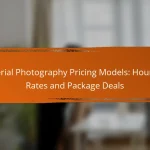What are the key cost factors in aerial photography?
The key cost factors in aerial photography include equipment costs, labor expenses, location-specific charges, insurance requirements, and permitting fees. Understanding these elements can help you budget effectively and make informed decisions when planning an aerial photography project.
Equipment costs
Equipment costs are often the most significant expense in aerial photography. This includes the purchase or rental of drones, cameras, and lenses, which can range from a few hundred to several thousand dollars depending on the quality and capabilities required. Additionally, consider the costs of accessories such as gimbals, batteries, and storage devices.
When selecting equipment, balance your budget with the quality needed for your project. High-end drones with advanced features may offer better image quality but come at a premium price. Renting equipment can be a cost-effective option for short-term projects.
Labor costs
Labor costs encompass the fees for skilled operators and support staff involved in the aerial photography process. Hiring a certified drone pilot can range from $50 to $200 per hour, depending on their experience and the complexity of the shoot. If post-production editing is required, factor in additional costs for graphic designers or editors.
To manage labor costs, consider hiring freelancers for specific tasks rather than full-time staff. This approach can help you save money while still accessing the expertise needed for high-quality results.
Location-specific expenses
Location-specific expenses can vary widely based on where the aerial photography is conducted. Costs may include travel expenses, accommodations, and local fees for accessing certain areas, especially if they are remote or require special access. For example, shooting in urban areas may incur higher parking or access fees.
Research the location thoroughly to identify any potential costs beforehand. Planning your shoot in less populated areas can often reduce these expenses significantly.
Insurance requirements
Insurance requirements are crucial for aerial photography, as they protect against potential liabilities. Many clients or locations may require proof of insurance, which can cost anywhere from a few hundred to several thousand dollars annually, depending on coverage levels. Liability insurance is particularly important to cover damages or accidents during the shoot.
Evaluate your insurance needs based on the scale and risk of your projects. Investing in comprehensive coverage can save you from significant financial losses in case of unforeseen incidents.
Permitting fees
Permitting fees are often necessary for conducting aerial photography, especially in regulated airspace or specific locations. Depending on your country, obtaining permits can involve fees ranging from nominal amounts to several hundred dollars. In the U.S., for instance, commercial drone operators must comply with FAA regulations, which may include obtaining a Part 107 certification.
Always check local regulations and apply for necessary permits well in advance of your shoot. This proactive approach can help avoid delays and unexpected costs associated with last-minute applications.
How does equipment choice affect aerial photography costs?
The choice of equipment significantly impacts the costs associated with aerial photography. Factors such as camera type, drone specifications, and stabilization gear can influence both the initial investment and ongoing expenses.
Camera type impact
The type of camera used in aerial photography can greatly affect the overall cost. High-end cameras with larger sensors and advanced features can range from several hundred to several thousand dollars. In contrast, entry-level cameras may be more affordable but could compromise image quality and functionality.
When selecting a camera, consider the intended use. For professional work, investing in a DSLR or mirrorless camera may be worthwhile, while hobbyists might find compact options sufficient. Always factor in additional costs for lenses and accessories that enhance performance.
Drone specifications
Drone specifications play a crucial role in determining aerial photography costs. Drones equipped with advanced features like GPS, obstacle avoidance, and high-resolution cameras typically come at a premium. Prices can range from a few hundred to several thousand dollars depending on these capabilities.
When choosing a drone, assess the flight time, payload capacity, and range. A drone with longer flight times and higher payload capacity allows for more extensive shoots, potentially reducing the need for multiple flights. Ensure compliance with local regulations regarding drone specifications and usage.
Stabilization gear
Stabilization gear is essential for capturing smooth, high-quality aerial footage. Gimbals and stabilization systems can add to the initial setup cost but are crucial for professional results. Prices for stabilization gear can vary widely, from affordable handheld gimbals to sophisticated systems costing thousands.
Investing in good stabilization gear can prevent shaky footage and improve the overall quality of your images. Consider your shooting environment; for example, windy conditions may necessitate more advanced stabilization solutions. Always evaluate the compatibility of stabilization gear with your chosen camera and drone setup.
What are the labor costs associated with aerial photography in the UK?
The labor costs for aerial photography in the UK can vary significantly based on the experience of the professionals involved and the complexity of the project. Typically, these costs encompass photographer rates, assistant wages, and post-processing expenses, all of which contribute to the overall budget.
Photographer rates
Photographer rates for aerial photography in the UK generally range from £300 to £1,500 per day, depending on their expertise and the project’s requirements. Experienced photographers with specialized skills in aerial work may command higher fees, while less experienced individuals may offer lower rates.
When hiring a photographer, consider their portfolio and past work to ensure they meet your project’s standards. It’s also wise to clarify what is included in their rate, such as equipment usage and travel expenses.
Assistant wages
Hiring an assistant can add to the labor costs, with wages typically ranging from £100 to £300 per day. Assistants help with equipment setup, safety checks, and other logistical tasks, allowing the photographer to focus on capturing high-quality images.
When budgeting for an assistant, factor in their experience level and the specific tasks they will perform. A skilled assistant can enhance the efficiency of the shoot, potentially saving time and reducing overall costs.
Post-processing costs
Post-processing costs for aerial photography can vary widely, often ranging from £50 to £500, depending on the complexity of the editing required. This may include color correction, image stitching, and retouching to ensure the final images meet professional standards.
Consider whether the photographer includes post-processing in their initial quote or if it will be an additional expense. Investing in quality post-processing can significantly enhance the final product, making it worthwhile for many projects.
How do location and project type influence aerial photography pricing?
Location and project type significantly impact the pricing of aerial photography services. Urban areas typically incur higher costs due to increased operational complexities, while the nature of the project—residential or commercial—also dictates pricing structures and service requirements.
Urban vs rural pricing
In urban settings, aerial photography costs tend to be higher due to factors such as airspace regulations, higher demand, and logistical challenges. For example, obtaining permits in cities may involve more bureaucracy, leading to increased fees. In contrast, rural areas often have fewer restrictions and lower demand, resulting in more competitive pricing.
Additionally, urban projects may require specialized equipment or additional safety measures, which can further elevate costs. Clients should anticipate prices that can vary widely, often from a few hundred to several thousand dollars depending on the complexity of the shoot.
Residential vs commercial projects
Residential aerial photography projects generally cost less than commercial ones due to the scale and scope of the work involved. Residential shoots might focus on single properties, while commercial projects often encompass larger sites, requiring more extensive planning and equipment. Pricing for residential projects can range from a few hundred to around a thousand dollars, depending on the specifics.
Commercial projects, on the other hand, may involve multi-day shoots, extensive editing, and additional services such as 3D modeling or mapping. As a result, these projects can start in the low thousands and go significantly higher based on the project’s requirements. Clients should clearly define their needs to ensure accurate quotes and avoid unexpected costs.
What are the permitting requirements for aerial photography in the UK?
In the UK, aerial photography requires specific permits and adherence to regulations set by the Civil Aviation Authority (CAA). Photographers must ensure they comply with airspace restrictions and obtain necessary permissions, especially when operating drones.
Local regulations
Local regulations for aerial photography in the UK vary by region and can impact where and how you can operate. It’s essential to check with local authorities and the CAA for any specific rules that apply to your intended location.
For instance, flying drones in urban areas often requires additional permissions due to higher population density and potential safety concerns. Always verify if you need to notify local councils or landowners before conducting your aerial photography.
Additionally, consider the restrictions around flying near airports, military bases, and other sensitive areas. Familiarizing yourself with these local regulations can prevent legal issues and ensure safe operations.






